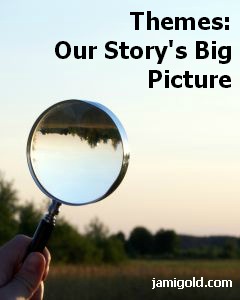My favorite blogger, Janice Hardy, had another great post last week. This time she talked about how writers can develop their theme. She shared three tips for understanding how themes work in our stories.
One of her tips struck me—a confirmed pantser—as a great way to keep our pantsed stories on track. When we draft stories by the seat of our pants, it’s easy to get sidetracked by tangents, subplots, interesting side characters, etc. That can make for a tough revision.
Okay, now here’s where all of you who have struggled with a hot mess of a pantsed story will hate me. Um, those sorts of don’t-fit-the-story tangents have never happened to me. Ever.
I know story structure backward and forward, so my knowledge trickles by osmosis into well-plotted stories despite my pantsing technique. But Janice’s post gave me insight into how that actually happens. Which means I can attempt to explain it to others. *smile*
How to Keep a Pantsed Story on Track? Know Your Themes
I use themes to keep my pantsing self on track. And Janice pointed out the now-very-obvious-to-me truth: You Can Have More Than One Theme.
Like in my NaNo project (which is fresh in my mind because I’m looking for beta readers right now), the story has several themes: love conquers all, discovering yourself, standing up for what you believe in, feeling worthy, finding redemption, sacrificing your desires for those you love, the difference free will makes, etc. Some of those apply to the story as a whole, some just to the hero or heroine, and some to their relationship together.
I knew only the high-level concepts when pantsed this story from beginning to end. A reveal in the hero’s first scene (that I didn’t see coming until I typed it) becomes a major plot point later on. And I didn’t have a clue how the big showdown would happen until I got there.
Yet all the scenes hung together and built into a coherent story from the very first draft. How did I manage that? By having vague ideas about those themes.
Those themes provided the framework to know what high-level concepts I wanted to accomplish. And more importantly, how to accomplish those concepts.
Themes Provide the Framework for Story and Scene Concepts
If we know the big picture with our themes, we’ll know whether this point A or that point A is a better start for the scene to get to point B. We’ll know what subtext to layer into the motivations. We’ll know what mood or tone will fit our goals. And if our muse tries leading us down a path that seems out of line, we can ask ourselves if it’s furthering the big picture we’re painting with our themes.
For example, when drafting this story, I was several pages into one scene and still didn’t have a clue where it was going. However, it fit the theme for the character and made sense plot-wise, so I followed my muse’s lead. A page later, a literal gun to the head forced the hero to make choices that set the next phase of his emotional arc into motion.
If I hadn’t known the theme, I might have deleted that scene before letting it play out. I might not have trusted my muse to give the scene a turning point. If I’d deleted it (and believe me, I was tempted), I would have been stuck for what should happen next.
Knowing the big picture themes gave me the confidence to trust in my muse. If my subconscious knows the themes, it will figure out a way to bring them into the story.
What If We Don’t Know Our Themes?
Often, our subconscious will know our themes better than we do. Many writers don’t consciously recognize their themes until after the story is done.
But I’d argue that we often know our themes better than we think we do. Themes are usually generic, like the “love conquers all” type ideas I listed above. And our themes often repeat from story to story because they usually reflect our personal worldview.
So all we pantsers might need to know is that our heroine’s theme is about discovering her inner strength. In other words, the theme is often a simplified, generic version of the story or character arc.
When we get an idea for a scene, we can make sure that scene has multiple reasons for existing—including illuminating the theme in some way. If the conflict follows the previous plot point and has our heroine question herself, that scene could be a perfect fit.
On the other hand, if the conflict doesn’t refer to any of the themes, maybe it could be tweaked. Not every scene has to refer to the themes, but I’d bet that most do, at least in subtle ways.
Scenes that do refer to the theme will likely be stronger. And more importantly, scenes that tie into the theme will help make our whole story more meaningful.
Do you have problems with unrelated tangents as you’re drafting? Do you know your themes in advance (at least in a vague way)? Do you think themes can help us shape a scene? Or know if it belongs at all? Have you used themes that way before?
(And Beta Readers, let me know if you’re interested. I’m reluctant to pester. *grin*)

